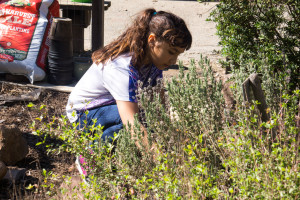 When I teach environmental literacy in my class I feel like I am opening a door for students to walk through. This door opens to empowerment, knowledge, and stewardship.
When I teach environmental literacy in my class I feel like I am opening a door for students to walk through. This door opens to empowerment, knowledge, and stewardship.
Children want to be big thinkers. The more I challenge them with big ideas the more they rise to the occasion, and learning about the environment entails some very sophisticated ideas. For the last six years I have made environmental literacy the theme for my entire literacy curriculum, and I’ve seen more engagement and critical thinking going on than I ever did previously. Each year my third-graders tackle topics such as bee colony collapse, renewable and non-renewable energy, global warming, the Pacific Garbage Patch, and several other similar topics. We read, research, build models, have debates and Socratic seminars—you should see how excited they are! When the topics are based on things that affect their world and their lives AND they have the opportunity to create possible solutions, that’s when the magic happens.
I’d like to share two of these topics in a more in-depth way. When learning about Bee Colony Collapse Disorder (CCD) my class read several nonfiction books and articles explaining about the life of bees, their role in nature, and CCD. We read older research with theories about why scientists thought CCD happened. Then we read current research and discussed the combination of mites and insecticides as the real reason. Students debated the use of insecticides and where our government stands in allowing these to still be used. We problem-solved other ways of ridding crops of insects that are not harmful to nature. They worked in teams on these projects and were really engaged in this problem. They applied their Close Reading strategies when reading articles, and had lots of opportunities to discuss what they read with other students.

Currently we are researching renewable and non-renewable resources and energy, and next week we will start building solar ovens, wind turbines, and models of hydropower. They will apply STEM and Next Generation Science Standards (NGSS) concepts and practices while working on their designs and challenging each other to improve their models. I’m inviting renewable energy companies in our area to come in as guest speakers to discuss the pros and cons of renewable energy in California. Then they will be reading, arguing, and finally writing a persuasive paragraph presentation on the form of renewable energy they feel is best for California.
Students want to feel responsible, needed, and to solve problems. They have the creativity and imagination to look at our world without thinking about what can’t happen or won’t work. Instead, they love to figure our possibilities. They also innately love nature so when you give them opportunities to help keep this beautiful planet clean and gorgeous they will jump right in.
When I first started using the EEI Curriculum it was to expose my students to environmental science. I was so excited when I discovered it had so much critical thinking and problem-solving embedded within. As time passed I found these units to be a perfect fit for Common Core and NGSS. These units provide my students with the background knowledge they need about their scientific world in addition to teaching them about human demands (and sometimes harm) on the natural world they love so much. It’s a perfect backdrop for me to create stewards who are champions for defending and protecting our beautiful planet.


